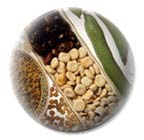- Home
- Introductions

|
Vegetable Seed Production: PrinciplesYou are here: Seed Production: Principles: Planting Planting The planting of vegetable seeds for seed production is generally done by direct seeding or transplanting of glasshouse grown seedlings. Biennial vegetable seed production, however, can be achieved using two planting techniques. The "seed-to-seed" method is done by planting biennial seed, allowing the resulting plant to overwinter without being transplanted, and harvesting the seed crop the following season. This method does not permit the selection or roguing of root or other genotypic characters. A majority of carrot and onion seed crops are produced by this method which is less expensive and complex than the "root-to-seed" method.
The "root-to-seed" method is done by planting biennial seed, removing the resulting plant (e.g., root) from the soil (in some cases stored), replanting, and harvesting the seed crop the following season. The replanted plant is referred to as a "steckling." This method permits the selection or roguing of root or other genotypic characters. It also decreases the time required for cultivar development. For example, onion bulbs adapted to dry regions can be planted in the spring in the desert regions of the southwest and then shipped for seed production to central California or the Pacific Northwest for planting in the early fall of the same year.
This is the most expensive method of vegetable seed production due to transportation, handling, and replanting costs. The benefits of checking genetic quality before replanting are important in vegetable seed production to maintain "true-to-type" cultivars. Vegetable seed crops must be planted so that sufficient vegetative development occurs to support optimum fruit and seed development. In addition, the increasing emphasis on hybrid seed production necessitates planting of male and female lines at times that assure successful pollination, a process known as nicking. This may require that genetically different male and female lines be planted at differing times so that synchronous flowering occurs. Most hybrid broccoli is transplanted and staggered plantings are necessary for the male and female lines to ensure proper nicking. Hybrid cauliflower and squash are direct seeded but because of the differences in time required for the male and female lines to flower, they are planted in a relay fashion where the earlier flowering line is planted first followed by the later flowering line.
Vegetable seed production also is unique from most agronomic crops because vegetables such as beets, carrots, and cabbage are biennials and must develop sufficient vegetative growth prior to cool temperature exposure in order that vernalization successfully induces flower formation the following season. Planting such crops too early causes winter kill or late season pest infestations. Planting too late results in a lack of vernalization which limits flowering and reduces seed yield. In some instances, vegetable seed producers opt not to start the seed crop by seed. Rather, to ensure optimum vegetative growth for vernalization, they plant some developed portion of the vegetative structure. This is commonly done with carrot and beet stecklings and onion bulbs which allows for maximum production of plant biomass before vernalization. Vegetable seeds also vary greatly in their tolerance to soil temperatures at planting. Pea, radish, and spinach require cool soil temperatures for optimum seedling emergence. Beets, cabbage, carrot, and onion are tolerant of cool soil temperatures although they do better in warmer soils. Squash and melons require warm soil temperatures for optimum seedling emergence. In regions with high summer temperatures, vegetables such as tomato, pepper, eggplant, and cucurbits are planted in the early spring to optimize flowering and seed set in early summer. Later plantings of these seed crops are possible by transplanting young plants previously started in glass houses. This avoids the delayed establishment of plants from direct seedings due to cooler night temperatures and wetter soils encountered in the early spring. Row spacings and planting densities of vegetable seed crops differ from those for fresh market production. Sufficient space for flower development, air movement to reduce pathogens, unrestricted access to inflorescences by pollinators, mechanical cultivation, and harvest operations are necessary for seed crops. In some cases (e.g., eggplant, pepper, tomato, muskmelon, watermelon), row spacings used for seed production are the same as those for fresh market production. In most cases, row spacings are different for vegetable seed production. In lettuce, the size of the head will be larger than the fresh market head in order that bolting is promoted. Large-head types are planted 25 to 30 cm apart while small-head and loose-leaf types are planted 15 to 20 cm apart. Similar considerations are encountered for cabbage.
Broccoli and cauliflower produce sizable seed stalks requiring rows 40 to 60 cm apart. Planting densities are often different as well in vegetable seed crops from fresh market vegetable crops. Beet seed production is accomplished at higher planting densities than beets harvested for their roots. Carrot, celery, and parsnip seed production is planted at densities much less than for root or stalk production. Higher planting densities of onions grown by the bulb-to-seed method reduces lodging of the large seed stalk scapes. The method (wind or insect) of pollination affects row spacings and planting densities. Vegetables that are wind pollinated include beet, sweet corn and spinach.
Insect pollinated vegetables include most of the cole crops, carrot, and onion. Row spacings and planting densities are also important considerations in the production of vegetable seed hybrids. In order to maximize the amount of hybrid seed produced, the optimum ratio of female to male rows must be determined. Next: Weed & Pest Control |